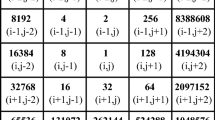Abstract
Cellular automata (CA) are simple dynamical systems used for solving simple as well as complex problems. It uses a discrete space, like the space used in spatial domain for image processing, to store the values of the input data. Then, the input data can be processed according to the transition rules, functions, or, programmes, for the required output. This research work presents an efficient algorithm based on two dimensional cellular automata (2D CA), with hybrid rules under null and periodic boundary conditions, for filtering high-density impulsive noise from corrupted digital images. The most important advantage of the proposed method is that, it can be applied on all types of digital images (binary, greyscale, or, true color). The paper is organized as follows: Sect. 1 gives a brief introduction towards the problem of noise in digital images with emphasis on its solution. Further, this section presents a brief review of existing standard noise filtering methods based on general image processing and CA techniques. Section 2 discusses the basic concept of CA with special emphasis on 2D CA and related concepts. Section 3 presents the proposed algorithm for the removal of high-density impulsive noise from corrupted digital images. Section 4 discusses, in detail, the experimental results using both mathematical and subjective analysis; and, the extensive experimentation reveals that the proposed 2D CA based algorithm yields better results than the standard noise filtering algorithms. And, then finally Sect. 5 presents the conclusions and future scope.






Similar content being viewed by others
References
Bovik A (2007) Handbook of image and video processing. Academic, New York
Gonzalez RC, Woods RE (2008) Digital image processing, 3rd edn. Prentice Hall, Englewood Cliffs
Sahin U, Uguz S, Sahin F (2014) salt and pepper noise filtering with fuzzy cellular automata. Comput Electr Eng (Elsevier) 40:5969
Yang R, Lin L, Gabbouj M, Astola J, Neuvo Y (1995) Optimal weighted median filters under structural constraints. In: Proceedings of the IEEE international conference on signal processing, vol 43, pp 591–604
Wang Z, Zhang D (1999) Progressive switching median filter for the removal of impulse noise from highly corrupted images. In: Proceedings of the IEEE international conference on circuits system, vol 46, pp 78–80
Zhang S, Karim MA (2002) A new impulse detector for switching median filters. IEEE Signal Process Lett 9(11):360–363
Qadir F, Peer MA, Khan KA (2012) Cellular automata based identification and removal of impulsive noise from corrupted images. J Glob Res Comput Sci 3(4):12–15
Qadir F, Peer MA, Khan KA (2012) An effective image noise filtering algorithm using cellular automata. In: Proceedings of international conference on computer communications and informatics, IEEE explorer, Coimbatore, India, pp 1–5
Peer MA, Qadir F, Khan KA (2012) Investigations of cellular automata game of life rules for noise filtering and edge detection. Int J Eng Electron Bus 4(2):22–28
Gonzalo H, Herrmann HJ (1996) Cellular automata for elementary image enhancement. J Gr Models Image Process 58(1):82–89
Popovici A, Popovici D (2007) Cellular Automata in image processing. In: Proceedings of the 15th international symposium on the mathematical theory of networks and systems, Romania, pp 1–6
Haiming W, Shide G, Daoheng Y (2004) A new CA method for image processing based on morphology and coordinate logic. Comput Appl Res 1(4):243–245
Selvapeter PJ, Hordijk W (2009) Cellular automata for image noise filtering. In: Proceedings of the world congress on nature, and biologically inspired computing, lecture notes in computer science, 193–197
Songtao L, Chen H, Yang S (2008) An effective filtering algorithm for image salt-pepper noises based on cellular automata. In: Proceedings of the IEEE congress on image and signal processing, vol 3, pp 294–297
Pourkashani M, Kangarvari MR (2008) A cellular automata approach to detecting concept drift and dealing with noise. In: Proceedings of the IEEE international conference on computer system and applications, pp 142–148
Rosin PL (2010) Image processing using 3-state cellular automata. Comput Vis Image Underst (Elsevier) 114:790–802
Chihyu H, Tashan T, Shyrshen Y, Kuokun T (2011) Salt and pepper noise reduction by cellular automata. Int J Appl Sci Eng 9(3):143–160
Jana B, Pal P, Bhaumik J (2012) New image noise reduction scheme based on cellular automata. Int J Soft Comput Eng 2(2):98–103
Nayak DR, Dash R, Majhi B (2015) Salt and pepper noise reduction schemes using cellular automata. In: Proceedings of 3rd international conference on advance computing, IEEE explorer, vol 2, pp 427–435
Priego B, Prieto A, Duro RJ, Chanussot J (2017) Spatio-temporal cellular automata-based filtering for image sequence denoising. In: International joint conference on neural networks, IEEE
Neumann JV (1966) Theory of self-reproducing automata. University of Illinois Press, Urbana
Wolfram S (1984) Computation theory of cellular automata. Commun Math Phys 96:15–57
Author information
Authors and Affiliations
Corresponding author
Rights and permissions
About this article
Cite this article
Qadir, F., Shoosha, I.Q. Cellular automata-based efficient method for the removal of high-density impulsive noise from digital images. Int. j. inf. tecnol. 10, 529–536 (2018). https://doi.org/10.1007/s41870-018-0166-4
Received:
Accepted:
Published:
Issue Date:
DOI: https://doi.org/10.1007/s41870-018-0166-4




